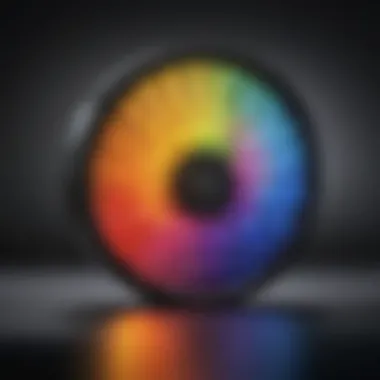Exploring the Science Behind Lightening Colors


Intro
The exploration of color lightening encompasses various scientific principles and practical applications. Lightening color involves altering shades or tints in materials such as textiles, paints, and cosmetics. This process is not merely aesthetic but rooted in chemistry and technological advancements. By understanding the mechanisms behind lightening colors, professionals and researchers can apply these concepts effectively in their respective fields.
Research Overview
Summary of Key Findings
Research reveals a multitude of methods for lightening colors, ranging from chemical agents to natural substances. Key findings include the effectiveness of hydrogen peroxide in textile treatments and the role of chlorine bleach in household cleaning products. Additionally, advancements in formulations for hair lightening indicate a growing market for safer, less damaging solutions. The implications of these findings highlight both the beneficial and detrimental aspects of lightening agents in industrial and consumer applications.
Background and Context
The scientific study of lightening colors has evolved significantly over recent decades. Initial methods were largely limited to traditional chemicals that often posed health risks. However, contemporary research emphasizes the development of more sustainable and eco-friendly alternatives. The increasing awareness of environmental impacts has shifted the focus towards safer options in industries such as cosmetics and textiles.
Methodology
Experimental Design
When examining methods used for lightening colors, a well-structured experimental design is essential. Commonly, researchers employ controlled experiments to measure the effectiveness of various lightening agents. For instance, textile samples may be treated with hydrogen peroxide of different concentrations to assess the degree of color change over specific time intervals.
Data Collection Techniques
Data collection may involve spectrophotometric analysis, where light absorption at various wavelengths indicates the extent of color alteration. Additionally, surveys and interviews can provide insight into consumer perceptions regarding safety and efficacy. Analyzing both qualitative and quantitative data allows for a comprehensive understanding of lightening processes.
"Understanding the science of lightening colors is crucial in developing safer products and minimizing environmental impact."
For more information on this topic, refer to resources such as Encyclopedia Britannica, or engage in community discussions on platforms like Reddit.
Discover more scientific principles related to color on Wikipedia.
Foreword to Lightening Color
The topic of lightening color holds significant importance in various fields such as art, textiles, and cosmetics. It allows for the manipulation of hues and shades, yielding both aesthetic and functional benefits. Understanding the science behind lightening colors can lead to innovations in product formulation, enhance artistic expression, and improve sustainability in any industry that uses color.
Definition of Lightening Color
Lightening color refers to the process of reducing the saturation or darkness of a pigment or dye. This can involve different techniques such as dilution with a lighter color, bleaching, or utilizing chemical agents. The goal is to achieve a lighter ting or to alter the final appearance of a material. By understanding the chemistry at play, professionals can make more informed decisions.
Historical Context
The historical context of color lightening can be traced back to ancient civilizations. For instance, the Egyptians developed early methods of fabric dyeing, experimenting with various natural agents that could modify color. Over centuries, advancements in chemistry have expanded these methods. The twentieth century saw the rise of synthetic dyes, which had a significant impact on the process of lightening colors, making it more efficient and accessible. Today, knowledge about lightening colors combines art, science, and technology, representing an evolution of techniques that inform contemporary practices.
Chemical Principles Behind Color Lightening
The foundational aspect of lightening colors lies in understanding the chemical principles that govern the process. Being aware of these elements not only adds depth to our comprehension but also enhances practical application in various fields such as art, textiles, and personal care. The chemistry involved plays a pivotal role in achieving desired outcomes concerning color modification and influences how various lightening agents act in different conditions. This knowledge enables more informed decisions when selecting products or methods for effective and safe color lightening.


Color Theory Fundamentals
Color theory provides a basis for understanding how colors interact, and this understanding is crucial when it comes to lightening processes. Traditionally, the color wheel illustrates primary, secondary, and tertiary colors, giving insight into complementary shades and color relationships. In the context of color lightening, the theory emphasizes how removing specific pigments can reveal lighter tones.
- Primary Colors: Red, blue, and yellow are the roots of all colors.
- Secondary Colors: Mixing primary colors yields green, orange, and purple.
- Tertiary Colors: These occur when primary and secondary colors mix.
The removal or alteration of color is linked to the perception of light. For instance, lighter shades tend to come from a decrease in saturation or brightness of the underlying pigments. That is why understanding interactions and layering is vital in achieving successful color lightening.
Oxidation and Reduction Processes
In the realm of chemistry, oxidation and reduction are processes that are significant in color lightening. Oxidation refers to the loss of electrons, while reduction involves gaining electrons. When discussing lightening, the common agents, like hydrogen peroxide, typically facilitate oxidation reactions to break down colored compounds.
- Oxidizing Agents: These generally strip away the electrons from pigments, leading to lighter hues. For example, hydrogen peroxide reacts with melanin in hair to create a lighter shade.
- Reduction Reactions: While less common in lightening, these can restore certain aspects of color. Understanding these processes helps in predicting the outcomes of different treatments based on the chemical composition of the agents used.
"Oxidation reactions are critical in altering color by breaking down larger pigmented molecules into smaller, less colored ones."
Role of pH in Lightening Solutions
The pH level of a lightening solution is another crucial facet that affects color results. pH describes how acidic or alkaline a solution is, which in turn influences the stability and effectiveness of various bleaching agents. Generally, a higher pH (alkaline) enhances the penetration of lightening agents into materials like hair or fabric.
- Acidic Solutions: These can stabilize colors but may limit the effectiveness of oxidation.
- Alkaline Solutions: They break down color more efficiently but can also lead to damage if not controlled properly.
Maintaining the right pH balance is vital for achieving optimal results in coloring processes. A solution that is too acidic may not lighten effectively, while one that is overly alkaline can lead to unwanted consequences such as damaged texture or compromised integrity.
By delving into these chemical principles, a clearer framework emerges for understanding lightening methods and achieving desired outcomes across various applications. Further exploration into practical methods of color lightening continues to illuminate the relevance of these chemical fundamentals.
Common Methods of Lightening Colors
Understanding the common methods of lightening colors is essential for those engaged in various industries, including art, textiles, and cosmetics. These methods not only impact the aesthetic quality of materials but also have significant implications on the environment and human health. Each method comes with its own set of techniques, benefits, and considerations that inform their usage and effectiveness. By delving into these methods, readers will gain insights into practical applications as well as the underlying science that governs their operation.
Bleaching Agents
Bleaching agents play a crucial role in the process of color lightening. These chemical substances are used to remove color from materials, whether it be fabrics, hair, or paper. Common bleaching agents include sodium hypochlorite, calcium hypochlorite, and hydrogen peroxide.
- Sodium Hypochlorite: This compound is widely used in household bleaches. It breaks down pigments in colored materials, effectively whitening and lightening them.
- Calcium Hypochlorite: Often found in pool sanitizers, it also serves as an effective whitening agent in both textiles and specific hair treatments.
- Hydrogen Peroxide: While this is also a bleaching agent, its specificity often allows for more controlled lightening, which is preferred in cosmetic applications.
Utilization of these agents demands care. The concentration of the agent, the type of material being treated, and the desired result all influence the effectiveness and safety of the process. Understanding these elements is vital in achieving the desired lightening effect while minimizing damage to the materials.
Hydrogen Peroxide Utilization
Hydrogen peroxide is a significant component in many color lightening methods due to its efficacy and availability. It operates primarily as an oxidizing agent, facilitating the oxidation of colored substances in materials. This process renders the materials lighter and can also alter their chemical structure, leading to changes in properties beyond mere color.
One of the key benefits of hydrogen peroxide is its versatility. It can be applied in various concentrations, making it suitable for gentle applications in cosmetics or stronger formulations for industrial use. Its oxidative properties allow it to be effective against a range of color pigments found in dyes or natural substances.
Considerations when utilizing hydrogen peroxide include:


- Concentration Levels: Higher concentrations can lead to quicker degradation of color but may damage the texture and integrity of the material.
- Time of Exposure: Prolonged exposure can result in over-lightening, which may require corrective measures.
- Compatibility with Materials: Some fabrics or hair types may react unpredictably to hydrogen peroxide, necessitating preliminary tests.
Lightening Natural Dyes
Natural dyes, derived from various plant and animal sources, require specialized methods for lightening due to their organic nature. The challenge presented by these dyes stems from their molecular structure, which is often resistant to conventional bleaching agents. Techniques for lightening natural dyes often center around chemical modification or employing eco-friendly alternatives.
Some effective strategies include:
- Using Citric Acid: This can alter the pH level of the dyed fabric, resulting in a gradual lightening effect without the harshness of traditional bleaches.
- Opting for Enzymatic Treatments: Enzymes can degrade color molecules found in natural dyes, allowing for a gentle lightening effect that preserves the integrity of the material.
- Solar or Air Drying: Natural processes that expose dyed items to sunlight can also fade colors over time in a more controlled manner.
Implementing these methods in lightening natural dyes is not only significant for artistic and textile endeavors but also helps promote sustainable practices within the industry.
Applications of Lightening Colors
The application of lightening colors is vital across various industries. It facilitates creative expression in art, ensures visual appeal in textiles, and enhances aesthetic appeal in cosmetics. Each field employs unique methods and principles, emphasizing the importance of insightful use of lightening techniques. Below, we examine three distinct areas: art and aesthetics, textile industry practices, and cosmetics and hair treatments.
Art and Aesthetics
In the realm of art, lightening colors contributes significantly to visual narratives. Artists often utilize various techniques to manipulate color tones, allowing for greater depth and emotional resonance in their work. Lightening agents, such as titanium dioxide or zinc oxide, are pivotal for achieving desired luminosity.
- The interplay of light and color enhances the viewer's experience. By adjusting color brightness, artists can draw attention to specific areas or create focal points in their compositions.
- For painters, understanding the chemical properties of pigments is essential. For example, using watercolors often involves mixing to achieve lighter shades.
- In graphic design, digital tools permit precise adjustments with ease, ensuring that an artist's vision is accurately mirrored.
Artists who adeptly understand color lightening push the boundaries of their craft, engaging audiences in profound ways.
Textile Industry Practices
The textile industry heavily relies on color lightening techniques. From fashion to home textiles, manufacturers utilize lightening processes to achieve a range of hues. Bleaching and dye removal are common practices that enhance product appeal.
- Bleaching Agents: Chemicals such as sodium hypochlorite are widely used to lighten fabrics. They are effective in producing a uniform color base, thus making it easier to dye fabrics in vibrant tones.
- Environmental Regulations: The industry faces scrutiny regarding the use of harmful bleaching agents. Companies must adhere to environmental standards, leading to an increase in safer alternatives.
- Trends in Sustainability: Brands are now exploring natural lightening agents that align with eco-friendly practices. This trend signifies a shift towards sustainable textile production.
Cosmetics and Hair Treatments
The cosmetics industry capitalizes on lightening techniques to enhance beauty products. Skin care and hair treatments often rely on lightening agents to provide desirable results.
- Skin Lightening: Many products are designed to reduce skin pigmentation. Ingredients such as hydroquinone and kojic acid are frequently used to achieve lighter skin tones.
- Hair Lightening: Hair dyes and bleaches utilize hydrogen peroxide to lighten strands. The choice of products influences the final color and texture of hair.
- Consumer Awareness: As consumers become more informed about potential side effects, the demand for safe alternatives increases. This has prompted companies to innovate and develop less toxic products.
In summary, the applications of lightening colors span creative, practical, and safety applications. Understanding the principles and standards of each industry enables experts to harness the full potential of color lightening. Whether through art, textiles, or cosmetics, the impact of lightening techniques remains significant, driving innovation and collaboration across fields.
Environmental Considerations
Understanding the environmental considerations of lightening colors is crucial for assessing both the impact of various methods and the future sustainability of these practices. Given the widespread use of bleaching agents across multiple sectors, it is imperative to explore not just their effectiveness but also the ecological ramifications associated with their use. This section will delve into how these agents influence both human health and the environment, as well as alternatives that may mitigate adverse effects.
Impact of Bleaching Agents
Bleaching agents, such as sodium hypochlorite, hydrogen peroxide, and calcium hypochlorite, have proven effective in various lightening applications. However, their environmental impact raises significant concerns.


When these agents are released into water systems, they can disrupt aquatic ecosystems.
- Toxicity to Marine Life: Many bleaching agents can be harmful to fish and aquatic plants, leading to biodiversity loss in affected habitats.
- Water Pollution: The residual effects from bleaching processes can contribute to water pollution, making it unsafe for human consumption and detrimental to agricultural practices.
- Greenhouse Gas Emissions: Some bleaching processes may emit greenhouse gases, exacerbating climate change issues.
These points highlight why stakeholders need to seek more environmentally friendly practices in lightening colors.
Sustainable Alternatives
As society becomes more aware of environmental issues, exploring sustainable alternatives to traditional bleaching agents is vital. Several innovative solutions exist that prioritize ecological health while maintaining effective lightening results.
- Enzyme-Based Products: Enzymes can replace harsher chemicals by breaking down pigments in a more environmentally friendly manner.
- Natural Bleach Alternatives: Substances like lemon juice or vinegar can serve as mild bleaching agents, providing safer options for both users and the environment.
- Biodegradable Compounds: The development of biodegradable lightening agents reduces pollution's long-term effects, allowing them to break down more easily in ecosystems.
"The transition to sustainable practices in color lightening is not merely an option; it is an urgent necessity for preserving our planet."
Future Trends in Color Lightening Techniques
The field of color lightening is continuously evolving, reflecting advancements in science and technology. This section discusses future trends that shape how colors can be lightened in various applications. Innovations and technological progress are significant for improving efficiency, safety, and sustainability. Understanding these trends is essential, as they inform educational, professional, and practical practices in diverse sectors like art, textiles, and cosmetics. Future techniques are often aimed at minimizing environmental impact while maximizing effectiveness.
Innovations in Chemical Formulations
Recent developments in chemical formulations are paving the way for more effective and safer lightening agents. Researchers are focusing on creating compounds that offer similar efficacy to traditional agents but with reduced toxicity. For example, formulations that utilize natural enzymes or plant-based ingredients can provide alternatives that minimize harm to skin and materials while achieving desirable lightening effects.
- Plant-Based Formulations: Innovations in botanical extracts that act as lightening agents are gaining traction. Such formulations tend to be less harsh compared to conventional chemicals, enhancing user safety.
- Enzymatic Bleaching: New enzymatic solutions are emerging that specifically target color molecules, providing precision lightening without damaging the base material. This is particularly crucial in textiles, where fabric integrity is vital.
- Smart Formulations: The integration of nanotechnology in lightening products is also being explored. These smart formulations allow for controlled release of active agents, maximizing the effectiveness while reducing the potential for adverse reactions.
Technological Advancements in Application
The application of color lightening agents is also being transformed through technological innovations. Modern techniques not only improve the application processes but also enhance outcomes in terms of efficiency and effectiveness.
- Precision Application Tools: Advancements in tools that allow for accurate application of lightening products are becoming mainstream. These tools can ensure even distribution, which helps achieve consistent results. This is especially beneficial in cosmetic and hair treatments, where precision is key.
- Automated Systems: Automation in the application process is becoming a trend in the professional sector. Machines that can apply lightening agents through sophisticated algorithms are being designed, leading to improved accuracy and reduced human error.
- Real-Time Monitoring: Technology now enables real-time monitoring of the lightening process. For example, devices equipped with sensors can measure the effectiveness of the lightening agent, allowing for adjustments while the process occurs. This can significantly minimize damage and optimize results, which is vital for industries that require exact specifications.
The future of color lightening techniques lies in combining scientific innovations with advanced technology. This synergy can lead to new practices that enhance safety and performance.
In summary, innovations in chemical formulations and technological advancements in application methods will play vital roles in shaping the future of color lightening. These changes not only help improve end products but also raise important questions about sustainability and safety related to the substances we use.
Finale
In the arena of lightening colors, the significance of understanding this domain extends beyond mere aesthetics. This article explored various aspects of color lightening, immersing into its chemical principles, practical applications, and environmental implications. Key insights have been highlighted that underscore the relevance and complexity of this field. The mechanics of color lightening require a clear comprehension of both the underlying science and the practical usage in various industries.
Recap of Key Points
- Chemical Principles: Understanding oxidation, reduction, and pH dynamics are fundamental to effective color lightening.
- Methods of Lightening: Various techniques such as bleaching agents, hydrogen peroxide, and natural substance treatments play crucial roles in different sectors.
- Applications: The expansive utilization of color lightening across art, textiles, and cosmetic industries illustrates its versatility and importance.
- Environmental Considerations: Awareness of the ecological impact of lightening agents prompts the search for sustainable alternatives.
- Future Trends: Innovations in chemical formulations and application technologies indicate a promising direction for color lightening practices.
The Role of Lightening Colors in Science and Society
The lightening of colors serves critical roles in both scientific inquiry and societal expressions. Scientifically, it aids in experimental techniques and research, catering to evolving norms in various sectors like chemistry and material science. It advances knowledge and fosters innovation, pushing boundaries of what can be achieved with color applications.
In society, color influences perceptions, emotions, and communications. Whether in fashion, art, or branding, lightening colors contribute to cultural significance. The techniques discussed not only enhance aesthetic appeal but also produce practical solutions in everyday life.
"Understanding the science behind lightening colors enhances not only professional practices but also enriches cultural expressions."
Emphasizing the integration of science with social applications underlines the interconnectedness of these fields. Thus, the study of lightening colors represents a fruitful intersection of theory and practical relevance.







